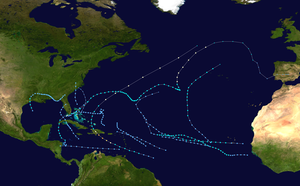| 1987 Atlantic hurricane season | |
|---|---|
 Season summary map | |
| Seasonal boundaries | |
| First system formed | May 24, 1987 |
| Last system dissipated | November 4, 1987 |
| Strongest storm | |
| Name | Emily |
| • Maximum winds | 125 mph (205 km/h) (1-minute sustained) |
| • Lowest pressure | 958 mbar (hPa; 28.29 inHg) |
| Seasonal statistics | |
| Total depressions | 14 |
| Total storms | 7 |
| Hurricanes | 3 |
| Major hurricanes (Cat. 3+) | 1 |
| Total fatalities | 10 total |
| Total damage | $90.01 million (1987 USD) |
| Related articles | |
The 1987 Atlantic hurricane season was a below-average hurricane season that was limited by an ongoing El Niño. The season officially began on June 1, 1987, and lasted until November 30, 1987, although activity began on May 24 when a tropical depression developed 400 mi (640 km) east of the central Bahamas. The June through November dates conventionally delimit the period of each year when most tropical cyclones form in the Atlantic basin. The first cyclone to attain tropical storm status was an unnamed tropical storm which formed on August 9, nearly a month later than usual.[1] The final storm of the year, Tropical Depression Fourteen, merged with a weak extratropical low on November 4. The season marked the first year tropical storm watches and warnings were issued; previously, gale watches and warnings were used for tropical storms, and this season was one of only a few seasons with no deaths in the United States; the last time this happened was in the 1981 season.
During this season, 14 tropical depressions formed of which seven attained tropical storm status. One tropical storm was operationally classified as a tropical depression but was reclassified in post-analysis. Three tropical cyclones reached hurricane status of which only one became a major hurricane, which is a Category 3 or greater on the Saffir–Simpson scale. Hurricane Emily was the costliest storm of the season, causing $80.3 million in damage (1987 USD) as it ravaged the Dominican Republic and Bermuda. Tropical Depression Fourteen was the deadliest storm of the season, causing six deaths as it passed across Jamaica. Of the seven cyclones that attained tropical storm status, three did not affect land.
- ^ "Tropical Cyclone Climatology". National Hurricane Center. 2006. Archived from the original on December 13, 2007. Retrieved November 24, 2007.